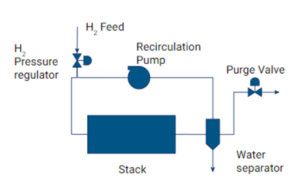With the BRAVA project being halfway, besides continued work on the FC catalyst (see executive summary of D4.4 ) and the preliminary design of the air supply system (see executive summary of D5.2) we emphasise in this newsletter the work in the Thermal Management System work package and specifically on the two-phase cooling (2-PC) system.
200 kW 2-PC system
There have been results on the development and demonstration of a 200 kW 2-PC system with a 20% lower mass than a conventional liquid cooling system and 50% lower pump power. A 2-PC with a cooling capacity with 1926 kW was analysed. This analysis was used to select methanol as cooling fluid for the 200 kW 2-PC demonstrator. Using a non-flammable alternative results in a much higher system mass with more information in the executive summary of D3.3 200 kW 2-PC concept design. The concept design for the 200 kW 2-PC and the results of the risk mitigation tests that are described in this report will be used for the detail design phase of the project.
Small-scale 2-PC FC demonstrator
For the “Small-scale 2-phase cooled fuel cell demonstrator” an overview of the current status was given with an executive summary of the D3.4 Mid-report on 2-PC FC. To allow demonstration of 2-PC, a suitable fuel cell short stack is being designed and a 2-PC mechanically pumped loop system for integration into a fuel cell test bench is developed by NLR. For the development of the short stack, Aerostack follows an iterative development process. The design activity is supported by CFD and thermal FEM modelling to improve the coolant flow distribution and provide suitable flow-fields for testing. Besides the coolant distribution, another important fact for fuel cell longevity are the operating conditions. More information on the current status can be found in the executive summary in D3.4 Mid-report on 2-PC FC.
Results on design and technology evaluation on aircraft PGS level
Mid-stage of the project there is also high level information on the progress in the work on Preliminary design and technology evaluation on aircraft PGS level. The aim was to evaluate potential options for the anode recirculation concept (see public deliverable D6.1) and the explanatory figure below on active anode recirculation and advantages and disadvantages discussed in the document as well as for its alternatives.

As well on the cathode path air recirculation with a report (see public deliverable D6.2) considering the evaluation of potential options to the cathode path. The proposal was focused on evaluating the benefits of cathode recirculation to prevent high cell voltages at idle power. Next to that two alternatives for humidification of the membrane were researched. The cathode recirculation concept has been abandoned due to the difficulty of implementation as well as the limited benefits and alternative architectures and controls were proposed for each problem. For more information see the public deliverable D6.2.

